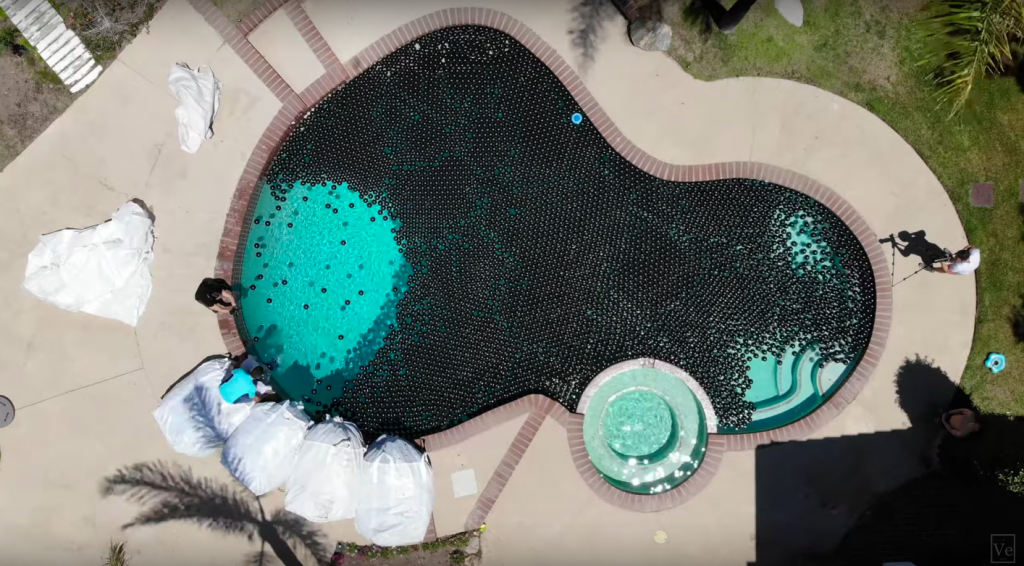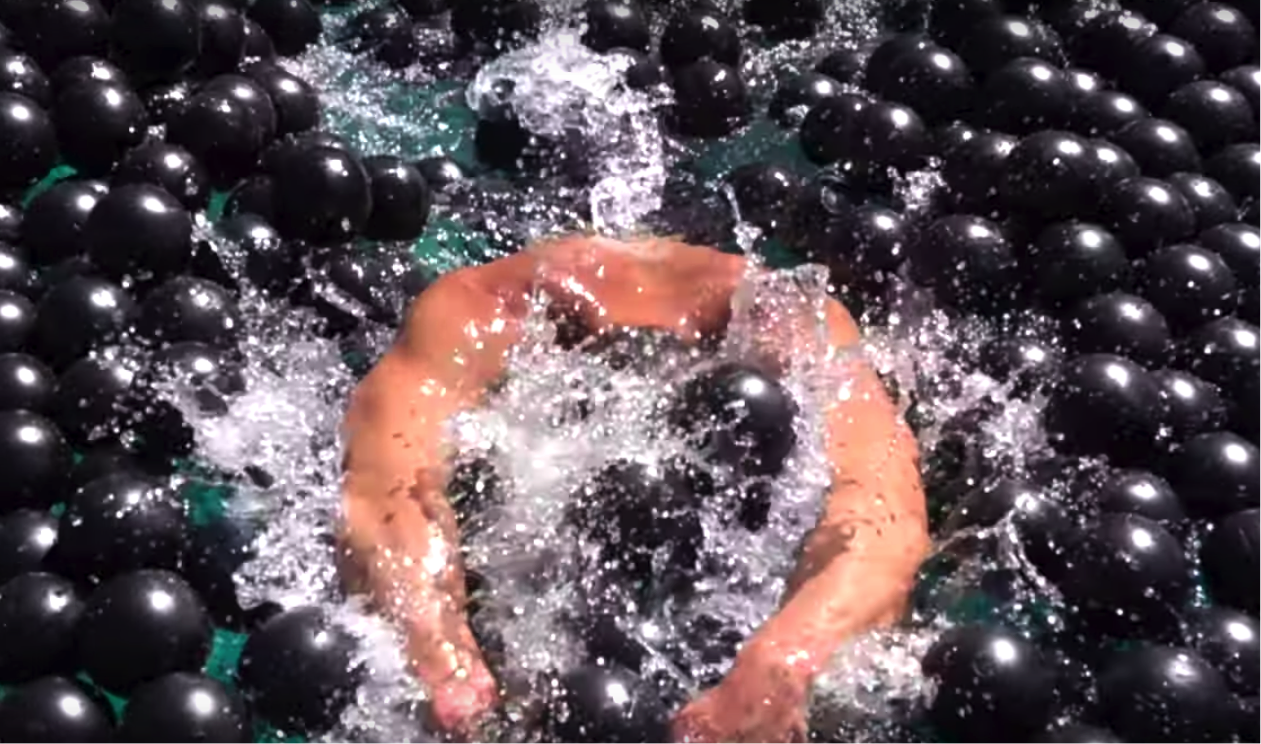Guest Post – Janis Bookout
Janis Bookout is a local environmental leader and the Executive Director of Earth Day Austin.
My son Ryan gets excited about YouTube videos. It’s a source of inspiration for him. Anyway, he showed me a YouTube video about 96 million plastic balls floating on the surface of the LA reservoir. The balls line up in overlapping patterns. They cover the entire surface of the reservoir. It’s stunning to look at and supposedly a major environmental solution.
On the surface of things (pun intended), it does appear to make a big difference. Covering the surface of the water in a few layers of these balls significantly reduces the production of bromate, a carcinogen, which forms more rapidly in sunlight. It does this while simultaneously reducing algal growth which limits the need to add chlorine to the water. It also reduces contamination from bird poop. But the balls are made with high density (food grade) polyethylene, and while they do have a carbon black additive for stability in sunlight, their lifespan is about 10 years. A dream come true? Maybe, maybe not.

Mayor Garcetti gives remarks at LADWP’s final deployment of shade balls at the LA Reservoir. 10 August 2015. Photo via Wikimedia Commons, Author Eric Garcetti
A Sphere Among Spheres
If you are familiar with my writing, you know I ramble with a purpose. That said, let me also share about another video Ryan showed me from the same YouTuber. In this follow-up video, he filled his own swimming pool with the balls in order to answer the question repeatedly posed by his viewing audience – “Can you swim in them?”.
The answer is yes, kind of, but it’s exhausting work. The way the balls move prevent any forward motion because ultimately, they provide more resistance. If you tried to swim out of the LA reservoir, you would surely drown before you got to the edge. What happens is, every forward motion sets into motion a reactive backlash by the balls. They move out of the way, but they come back and push back on the swimmer. They also get in the way of access to the water, where the arms can move the body forward. The added the resistance of the balls makes it nearly impossible to sustain forward motion. The man’s head became a sphere among spheres.
Watching the guy struggle against the resistance on the surface of the pool reminded me a lot of how we approach change in this country. We try to push our ideas forward against the resistance, but the push back makes our progress difficult. So why does this happen? I have a theory.
Leadership At The Surface
In the western world, the inherited mindset of imperialism, westward expansion, and industrialism is embedded in our thought patterns. It makes sense if you think about it — the wealth of our society (more for some than others) was built on the shoulders of this approach. So our inherited cultural conversations are bound to include justifications of exploitation and create a positive spin on the whole thing. But it is much more imbedded than we think. Innovations, solutions, social movements, campaigns, business models, educational models, political movements — they all share the language of expansion and growth. We think in solutions that can spread and make sweeping improvements.
Environmental advocacy is not exempt. Our language of change reflects imperialism and industrialism, even when we are trying to combat the impacts of it. We talk about “growing the movement,” and “moving toward a better future.” However, imperialism and industrialism were built upon the exploitation of people and natural resources. How does it limit our effectiveness that imperialist thinking infuses our language of change? How does it limit our inclusiveness?
A Deeper Dive
But let’s go back to the balls for a minute. Those of us trying to change the world often come at it opinion first — like we’ve figured it out and just need to sort out how we can get everyone else to think like us, adopt our model, spread the word. But just as the balls on the water move quickly back together to fill the surface, our efforts are often swallowed back up by the pull for the status quo. And like swimming in shade balls, it’s exhausting.
But I noticed something in that second video. The balls float. That means that just under the surface of the water, there is little to no resistance. If the swimmer in the video had only stopped trying to deal with the balls on the surface and dived just a little deeper, he would have been able to swim much farther, coming to the surface only to take a breath. When swimming in shade balls, it’s only trying to remain on the surface of the water that is problematic.
How might this weird little analogy inform our approach to change? Well, maybe if we go just a little deeper — listen to people and their real experiences, set aside our tendency to jump to a solution and instead pay attention to the problem, how its impacting different people, and why it’s happening — maybe then we can find the path of least resistance.
I am talking about getting pushback when attempting to make a difference at the surface of things. It must be noted that many people encounter this pushback at a much more personal level when they attempt to advocate for themselves in a world that is not designed to serve them. Or worse, designed to keep them them in their societal role. Here is where I think we reach the limits of the analogy, because for some, constantly arguing for basic access to the tools for your survival require a similar exhausting experience, and there is no getting around it, over it, or underneath it.
Everything That Glitters…
Now, on an interesting and ironic note, PBS reported recently on the larger impact of the shade balls. According to a recent study of the life cycle of the balls (from material extraction to manufacturing, delivery and use), the 96 million balls used between 66 and 766 million gallons of water. This is called the “water footprint,” which has a great explanation here. Additionally, a significant amount of oil and natural gas were used as well.
According to the study, shade balls don’t save water. Since the beginning of their deployment in 2008, the shade balls saved an estimated 1.15 million cubic meters of water, while an estimated 2.9 million cubic meters were used in production. According to the video my son showed me, the life of the balls is about 10 years. By comparison, the single most effective use of resources that the LA Water department used to save water was incentivizing savings — truly very simple. So is it really that effective even considering the reduction in bromate? Singular solutions often have unintended consequences.
LA is now moving away from using the balls. Not knowing all the ins and outs of the LA situation, my ability to judge their choices is severely limited. Mostly, it’s the analogy I am more interested in. In this little mental exercise, I am left in an inquiry — why do we spend so much time at the surface? And what if we all decided to just go a little bit deeper? As long as I am operating against all of the opinions out there in the world and offering my own small sphere as the solution, then I don’t have to look for what will actually take me across the pool. As long as I hold my own view as more valid than others, I will remain on the surface of the issue, fighting against the resistance. When I go deeper, and become aware of all the various perspectives, respecting each other’s different view points, building relationships beyond opinion, maybe something else becomes available. I would totally dive into that.
Please note – editorials and sponsored posts are written by guest writers to inform and educate the community on a variety of different viewpoints, as well as to share information about local eco-friendly businesses and organizations. However, they do not necessarily reflect the opinions of the Austin EcoNetwork.




